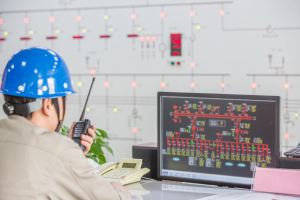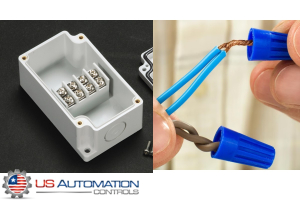When to Use a PNP/NPN Converter Circuit: Common Applications

PNP and NPN transistors are crucial components in industrial wiring since they control the current flow in circuits. By understanding these two types of transistors well and knowing when and how to convert their output signals, you can significantly benefit from using them. This article will walk you through the most common applications of PNP to NPN converter circuits, explain why you need to use them and provide a guide on how to use them effectively.
What Are PNP and NPN Transistors?
When it comes to any circuit that needs a bipolar junction transistor (BJT), PNP and NPN (respectively "positive-negative-positive" and "negative-positive-negative") transistors are the primary choices. The difference between these two is in the type of charge carriers and the direction of the current flow. Both transistors are activated by a small current being applied to the base. However, in the case of that current being applied, the current flows from the emitter to the collector in a PNP transistor, while it's the opposite for an NPN transistor (the current flows from the collector to the emitter).
In other words, PNP transistors are practical when the load needs to be connected to a positive voltage, but NPN transistors come in handy when the load needs to be connected to a negative voltage (which is commonly the ground). Different industrial components work with either PNP or NPN transistors. From sensors to actuators, different industrial components may require PNP to NPN conversion to avoid any compatibility issues. Thus, knowing the distinctions between these two transistors is essential.
Why Convert Between PNP and NPN?
In industrial settings, there are many instances where two components need to interface, but their input/output protocols are not compatible. For example, a PNP sensor may need to be connected to a PLC (Programmable Logic Control) that only inputs NPN signals. Such cases necessitate using a PNP/NPN converter to avoid compatibility issues and malfunctions.
There are many reasons why the two ends of an interface might be incompatible pairs of components. Different manufacturers make their components with different standards, and sometimes, in MRO applications, the only replacement for a failing PNP sensor is an NPN sensor. Ultimately, it's common for all devices not to be compatible and should be wired with some signal conversion in an industrial setting.
As a more concrete example, consider a conveyor belt system that uses a PNP sensor to detect an object being on the belt. However, suppose the control system you use to stop the conveyor belt receives only NPN signals. In that case, you will need a PNP to NPN converter circuit to make the two devices compatible and wire the system effectively.
When making changes to a system, whether it be repair or scaling, you may need to change the functionality of such converters. You may have used PNP-to-NPN transistor conversion, but now you need NPN-to-PNP conversion instead. Since there could be instances where you need a PNP-to-NPN conversion, an NPN-to-PNP conversion, or isolation, buying a configurable PNP/NPN converter circuit is advisable to help you with different scenarios.
Common Applications of PNP/NPN Converter Circuits
There are several PNP/NPN converter applications in industrial wiring. Some scenarios are:
Interfacing Different Logic Levels
In many cases, control systems use logic that is different from that of the other equipment. A very common example is PLCs (Programmable Logic Controllers) requiring logic that is different from that of a sensor.
Another example is a microcontroller that has a different logic from that of a relay or actuator. In general, any mismatch between the signal that a controller expects and the signal from the devices it controls necessitates using a PNP/NPN converter circuit.
Switching Applications
Industrial settings usually use transistors to control larger loads, which calls for another one of PNP/NPN converter applications. Thus, motors or many other components may need a transistor to control them.
If a PNP transistor controls a motor and the control signal comes from a circuit with an NPN system, the signal needs to be converted before it reaches the PNP transistor that controls the motor.


Signal Level Shifting
If the different components in a control system operate at different voltage levels, signal level shifting becomes necessary. Here, signals may need to stay the same, but the voltage needs transistor conversion to be shifted to another level. A PNP/NPN converter circuit can help achieve this.
Automation Systems
Whether in assembly lines, robotic operations, or material handling, automation systems are complex systems that need different controllers, relays, actuators, sensors, etc., to work together in harmony. This is where the PNP/NPN converter application comes into play. This application often involves a mix of PNP and NPN components, which necessitates the use of PNP/NPN converter circuits.
Using Pre-Manufactured PNP/NPN Converter Circuits
Whether you want to convert PNP to NPN or NPN to PNP, your signals can be converted easily using a PNP/NPN converter circuit. From convenience to improved safety, pre-manufactured PNP/NPN converter circuits have many advantages over DIY converter circuits. Here's why you should consider using a pre-manufactured PNP/NPN converter circuit:
Convenience: Pre-manufactured converters are easy to use, and you don't have to go through a time-consuming implementation process to use them. Moreover, you can get both PNP-to-NPN and NPN-to-PNP converter circuits in one component.
Reliability: When made manually, converter circuits are more prone to malfunction and general tear and wear.
Space-saving: When implementing a DIY converter circuit, making the outcome as small as pre-manufactured converter circuits is very difficult.
Cost-Effectiveness and Warranty: Overall, using a pre-manufactured converter circuit is more cost-effective considering its quality compared to the price. Moreover, commercial PNP/NPN converter circuits usually have a warranty and technical support.
Industrial Standards: Pre-manufactured converter circuits are made to function in various temperatures, work reliably, and meet the standards of an industrial setting far better than the DIY options.
Safety: Using a commercial converter circuit reduces the risk of electrical shock and is much safer than a DIY option.


High-Quality PNP/NPN Converter Circuits from Your Trusted Supplier in Short Hills, NJ
Do you need PNP/NPN converter circuits? US Automation Controls is your go-to supplier of automation control circuits and industrial control systems wholesaler. With high quality and competitive pricing, USAC has been the premier automation controls distributor in Short Hills, NJ, for more than 50 years. We offer an extensive inventory of automation controls, including PNP/NPN converter circuits.
Shop with us and get your reliable automation controls with a money-back guarantee!
Frequently Asked Questions
What are some common mistakes to avoid when designing a converter circuit?
Common mistakes include:
- Using incorrect resistor values.
- Failing to account for the maximum current ratings of the transistors.
- Neglecting to include protective components like diodes, which can lead to circuit failure.
How can I test a PNP to NPN converter circuit?
You can test the circuit by applying a known input signal and measuring the output at the load. Use a multimeter to check voltage levels and ensure the circuit operates as expected.
Are there alternative methods to convert PNP signals to NPN?
Yes, alternative methods include using integrated circuits designed for level shifting or opto-isolators, which can provide electrical isolation between different circuit parts.
What safety precautions should I take when working with transistors?
Always ensure that the power supply is turned off before making any connections. Use appropriate protective gear and be mindful of the components' current and voltage ratings to prevent overheating or damage.







